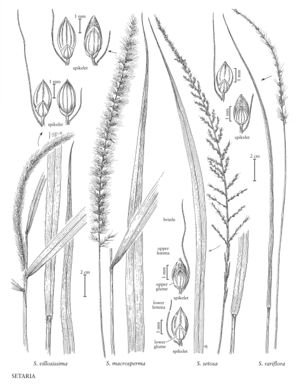Setaria setosa
Plants perennial. Culms 50-100 cm; nodes usually glabrous. Sheaths glabrous or finely pubescent, margins ciliate distally; ligules of 1 mm hairs; blades 15-20 cm long, 6-12 mm wide, flat or folded, often finely pubescent on both surfaces. Panicles 15-20 cm, loosely spikelike, interrupted, attenuate; rachises often villous; branches ascending, lower branches about 2.5 cm; bristles usually solitary, less than 10 mm, antrorsely scabrous. Spikelets 2-2.5 mm, ovate-lanceolate. Lower glumes about 1/2 as long as the spikelets, 3-veined; upper glumes about 2/3 as long as the spikelets, 5-7-veined; lower lemmas equaling the upper lemmas; lower paleas as long as the upper paleas, broad; upper lemmas finely and distinctly transversely rugose. 2n = unknown.
Distribution
Puerto Rico, N.J., Virgin Islands, Ala., Fla.
Discussion
Setaria setosa is native to the West Indies and Mexico. It is probably a recent introduction to Florida, but appears to be established there. The specimen from New Jersey was from a ballast dump; the species is not established in that state.
Selected References
None.
